In Ad Tech Wars, Disney Counts on YODA for an Edge
Unified ad platform will eventually service all of Disney’s ad supported businesses

With YODA in place, The Walt Disney Co.’s advertising-sales operation believes the Force is with it.
That’s not Yoda, the ancient Jedi master who trained Luke Skywalker in the original Star Wars movie. Or even Baby Yoda, the cute character from The Mandalorian, aka Grogu.
YODA stands for yield optimization delivery algorithm, which is a part of Disney’s programmatic ad-management platform. It’s one of the latest parts of the ad tech stack Disney engineers are building to help the company cash in as it pivots from linear to digital advertising. (Another piece of Disney ad tech is named after Drax, a character from Guardians of the Galaxy.)
The ad tech complements the premium Disney content with which advertisers have traditionally wanted to associate their brands.
The foundation of the tech and data investments Disney has been making to support its ad business is the global unified advertising platform initiative it started about three years ago.
“We have this vision of needing to invest in our own underlying technology platform for advertising as more consumption happens on addressable platforms like Hulu or Disney Plus so that we would have the capability to not only effectively deliver advertising in those environments, but also be able to string them together as advertisers are looking to be able to aggregate audiences at scale and reach them no matter where they are across the Disney ecosystem,” Jeremy Helfand, executive VP, ads and data platforms, Disney Entertainment & ESPN Technology, told Broadcasting+Cable.

The Disney ad server was launched early last year with Hulu and Disney Plus was added in December.
Broadcasting & Cable Newsletter
The smarter way to stay on top of broadcasting and cable industry. Sign up below
“If we had not had the forethought of having that ad server and that platform available, it would have been very difficult to meet the needs of the Disney Plus with advertising launch,” Helfand said.
The platform is designed to address where Disney thinks the ad business is heading, in terms of being able to use first-party data to better target viewers and the increasing amount of buying being done using programmatic technology.
Helfand notes that an increasing percentage of Disney’s ad business is coming through either programmatic or self-service platforms. “Increasingly, programmatic is the new scatter,” he said.
YODA is designed to put direct buyers and programmatic buyers on equal footing when their orders come in and inventory has to be allocated for their campaigns. YODA uses machine learning and data science to optimize effectiveness for clients and maximize yield for Disney.
Making Addressability Automatic
Disney has stated a goal to make 50% of its addressable advertising come through automated pipelines. Part of that is programmatic and another part is self-service buying by clients through Disney Ad Manager.
“We work with over 5,000 advertisers now and about a third of them are working with us programmatically,“ Helfand said. ”At any given point in time you’re talking about thousands of advertisers who may have an ad that is appropriate for a given slot. So in near-real time, we’re looking across our ecosystem, telling our advertising partners as much as we can in a privacy-compliant way about the piece of inventory that's available.”
Disney Ad Manager gives smaller advertisers access to advertising on Disney content, Helfand said. Adding smaller advertisers to the mix creates the opportunity to generate more revenue, but it also means a greater variety of ads are served, which enhances the viewer experience, he said.
The ad platform is separate from the platform that actually plays content on Disney digital and streaming platforms, but they work closely together reporting to Aaron LaBerge, the chief technology officer for Disney Entertainment and ESPN.
Such coordination is vital to create the best experience for the viewer while integrating ads into the storytelling. Data enhances the experience by making the inserted ads more relevant to viewers. The technology also enables formats like pause ads (that appear when the viewers pauses the show) and binge ads (that promise that the next episode of a show will be ad-free thanks to the sponsor) that are less disruptive.
When a more traditional ad break is required, Disney limits the length to 90 seconds. On Hulu, a clock shows how much time is left before the content resumes. For some consumers, that clock moves too slowly, but Disney testing has shown that the clock sets expectations for the viewer.
“We found better results [with the clock] because at the end of the day, you’re trying to maximize engagement with the platform and also deliver a higher return on investment for the advertisers,” Helfand said.
A Nimble Platform
Having its own platform enables Disney to quickly turn out new ad products and deploy them everywhere in the Disney ecosystem. The platform also helps create a differentiated product in which the playback experience is enhanced by smoothly integrating relevant advertising into the content viewers are watching.
The ad tech group also works hand-in-glove with the ad sales group, headed by Rita Ferro.
“We do a lot of work closely together,” Helfand said. “What does the market want? What do they need? They'll go out and secure lighthouse customers for some of the new products that we want to test.”
The tests are designed to determine both how effective commercial formats are for the advertisers, but also how they affect engagement with the consumer.
The formats also have to help Disney’s bottom line. “The benefit comes in a couple different ways,“ Helfand noted. “One is increased revenue. The other is operational efficiency. We don't have to have as many people having to manually manage campaigns. They can create higher amounts of value for our advertisers if they don't have to do a lot of that. So you’ve got to look at both the revenue gain as well as the cost reduction. Sometimes they satisfy both.”
Disney recently announced that the ad-supported version of Disney Plus will be rolling out in Europe this year, enabled by the Disney Ad Server.
“Ultimately, our goal is that every brand that has advertising will be powered by the global unified advertising platform and the Disney ad server,” Helfand said.
Having the technology in-house is a benefit to advertisers because they don’t have to seek out and pay other ad tech vendors.
“We have a large ecosystem of partners and making our platform interoperable with those partners is key,“ Helfand said. “But the fact that you're coming directly to Disney does make it more efficient. The other thing that I would say is because we can create those insights more quickly than you can optimize and reduce waste as well.”
Eyeing an Edge Over Netflix
The technology should also give Disney Plus an advantage over Netflix, which also last year launched an ad-supported service. “In order to deliver the very best viewer experience, having your ad technology deeply integrated into the service is really important,” he said. “I think we have a distinct advantage not only over Netflix but you know, many of our competitors.”
At Disney’s upfront presentation last month, Ferro touted the company's technology and data capabilities.
“Every time we go into an upfront like this, clients want to know about the new products and capabilities. So whether it's rolling out new formats, new first-party data solutions for measurement or currency or the ability to take advantage of programmatic and self-service, it’s really important.”
Helfand says Disney sees itself competing with the big digital native companies that grew up using audience data to power their advertising businesses, like Google, Facebook and Amazon.
“We need to make sure we have the very best audience-based advertising capabilities in market,” he said. “If you marry that with the unparalleled content that Disney has, then we can outcompete everybody.”
Jon has been business editor of Broadcasting+Cable since 2010. He focuses on revenue-generating activities, including advertising and distribution, as well as executive intrigue and merger and acquisition activity. Just about any story is fair game, if a dollar sign can make its way into the article. Before B+C, Jon covered the industry for TVWeek, Cable World, Electronic Media, Advertising Age and The New York Post. A native New Yorker, Jon is hiding in plain sight in the suburbs of Chicago.

